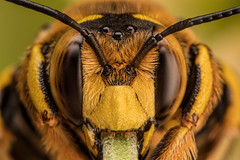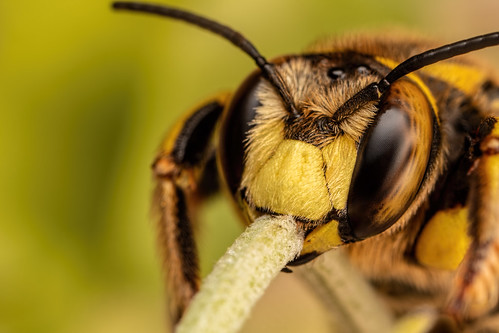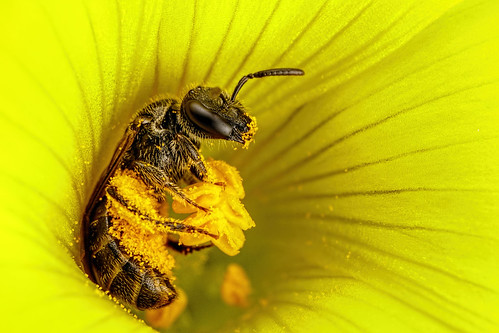When you're shooting you also need to be conscious of how the light is going to bounce off of the immediate surroundings and potentially change color. This shot was taken at my patio table, the same white plastic one in the video. By keeping the subject close to the table I'm able to use it like a bounce card to keep from crushing the shadows, and because it's white there's no change to the white balance of the light:
Here's another European Wool Carder Bee, only this one was shot while sitting on a yellow flower. Notice the warmer tones due to the shift in white balance:
The shadows are even lighter in that shot since the subject is closer to the "bounce card". I rarely change the white balance in post, preferring to allow the light to change based on what it reflected off of because it keeps my light from looking exactly the same all the time. Here's an extreme example of how the light can change after bouncing off of an object and back to the subject. The flower was a mix of oranges and reds, and notice how the specular highlights in this Long Horned Beetle took on the color:
I don't mind how the light changed, in fact I kinda like it. But as you work on your lighting you need to understand how the surroundings can change the quality of it. The diffuser isn't the only thing that's modifying the light from your flash. Even the artificial flowers that I use for the background in a lot of my images can effect the white balance, and in turn change the tone of the light and how the colors are rendered.
Last, but not least, I'd like to mention that the angle of the light can also make a difference in the detail that you pick up and how 3D a scene will look. I like shooting Sweat Bees in Sour Grass Flowers while they are foraging for pollen because it's tricky, and because it makes for a more interesting photo than shooting them when they are lethargic. This first shot is with both flash heads on the Canon MT-24EX flash mount:
Same species, same type of flower, and about the same magnification but this time the key (the "A" flash head) is on a Kaiser Adjustable Flash Shoe and it's firing at a low angle with respect to the flower. Notice how there's more texture in the flower and the subject:
So not only will using a more diffused light source give you more detail, but the angle of the light also makes a difference.
If you have any questions just drop me a comment here, or on the Extreme Macro Facebook page. Until next time happy shooting :)







2 comments:
Hi John, did you ever try Cinegel #3026 sheets as a diffusion material?
I don't remember using that specific material, but I've got some diffusion gels that are very similar and they didn't work nearly as well as the 1/4 stop white silk that I use now.
Post a Comment